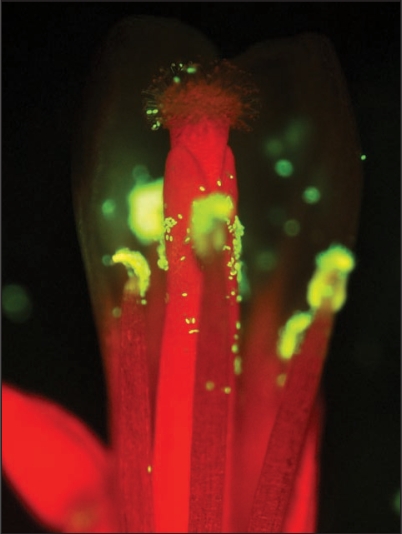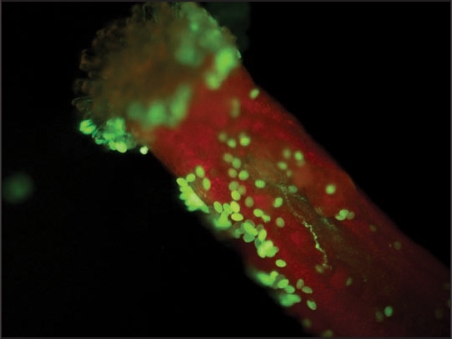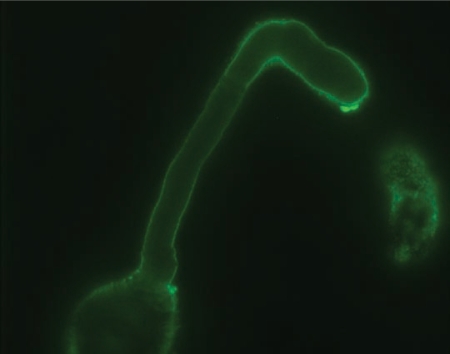Abstract
Some AGP molecules or their sugar moieties are probably related to the guidance of the pollen tube into the embryo sac, in the final part of its pathway, when arriving at the ovules. The specific labelling of the synergid cells and its filiform apparatus, which are the cells responsible for pollen tube attraction, and also the specific labelling of the micropyle and micropylar nucellus, which constitutes the pollen tube entryway into the embryo sac, are quite indicative of this role. We also discuss the possibility that AGPs in the sperm cells are probably involved in the double fertilization process.
Key words: Arabidopsis, arabinogalactan proteins, AGP 6, gametic cells, pollen tube guidance
The selective labelling obtained by us with monoclonal antibodies directed to the glycosidic parts of AGPs, in Arabidopsis and in other plant species, namely Amaranthus hypochondriacus,1 Actinidia deliciosa2 and Catharanthus roseus, shows that some AGP molecules or their sugar moieties are probably related to the guidance of the pollen tube into the embryo sac, in the final part of its pathway, when arriving at the ovules. The evaluation of the selective labelling obtained with AGP-specific monoclonal antibodies (Mabs) JIM 8, JIM 13, MAC 207 and LM 2, during Arabidopsis pollen development, led us to postulate that some AGPs, in particular those with sugar epitopes identified by JIM 8 and JIM 13, can be classified as molecular markers for generative cell differentiation and development into male gametes.
Likewise, we also postulated that the AGP epitopes recognized by Mabs JIM 8 and JIM 13 are also molecular markers for the development of the embryo sac in Arabidopsis thaliana. Moreover, these AGP epitopes are also present along the pollen tube pathway, predominantly in its last stage, the micropyle, which constitutes the region of the ovule in the immediate vicinity of the pollen tube target, the embryo sac.3
We have recently shown the expression of AGP genes in Arabidopsis pollen grains and pollen tubes and also the presence of AGPs along Arabidopsis pollen tube cell surface and tip region, as opposed to what had been reported earlier. We have also shown that only a subset of AGP genes is expressed in pollen grain and pollen tubes, with prevalence for Agp6 and Agp11, suggesting a specific and defined role for some AGPs in Arabidopsis sexual reproduction (Pereira et al., 2006).4
Therefore we continued by using an Arabidopsis line expressing GFP under the command of the Agp6 gene promoter sequence. These plants were studied under a low-power binocular fluorescence microscope. GFP labelling was only observed in haploid cells, pollen grains (Fig. 1) and pollen tubes (Fig. 2); all other tissues clearly showed no labelling. These observations confirmed the specific expression of Agp6 in pollen grains and pollen tubes. As shown in the Figures 1 and 2, the labelling with GFP is present in all pollen tube extension, so probably, AGP 6 is not one of the AGPs identified by JIM 8 and JIM 13, otherwise GFP light emission would localize more specifically in the sperm cells.5 So we think that MAC 207 which labels the entire pollen tube wall (Fig. 3) may indeed be recognizing AGP6, which seems to be expressed in the vegetative cell. In other words, the specific labelling obtained for the generative cell and for the two male gametes, is probably given by AGPs that are present in very low quantities, apparently not the case for AGP 6 or AGP 11.
Figure 1.
Low-power binocular fluorescence microscope image of an Arabidopsis flower with the AGP 6 promoter:GFP construct. The labelling is evident in pollen grains that are being released and in others that are already in the stigma papillae.
Figure 2.
Low-power binocular fluorescence microscope image of an Arabidopsis ovary with the AGP6 promoter:GFP construct. The ovary was partially opened to show the pollen tubes growing in the septum, and into the ovules. The pollen tubes are also labelled by GFP.
Figure 3.
Imunofluorescence image of a pollen tube growing in vitro, and labeled by MAC 207 monoclonal antibody. The labelling is evident all over the pollen tube wall.
After targeting an ovule, the pollen tube growth arrests inside a synergid cell and bursts, releasing the two sperm cells. It has recently been shown that sperm cells, for long considered to be passive cargo, are involved in directing the pollen tube to its target. In Arabidopsis, HAP2 is expressed only in the haploid sperm and is required for efficient pollen tube guidance to the ovules.6 The same could be happening with the AGPs identified in the sperm cells by JIM 8 and JIM 13. We are now working on tagging these AGPs and using transgenic plants aiming to answer to such questions.
Pollen tube guidance in the ovary has been shown to be in the control of signals produced by the embryo sac. When pollen tubes enter ovules bearing feronia or sirene mutations (the embryo sac is mutated), they do not stop growing and do not burst. In Zea mays a pollen tube attractant was recently identified in the egg apparatus and synergids.7 Chimeric ZmEA1 fused to green fluorescent protein (ZmEA1:GFP) was first visible within the filiform apparatus and later was localized to nucellar cell walls below the micropylar opening of the ovule. This is the same type of labelling that we have shown in Arabidopsis ovules, using Mabs JIM 8 and JIM 13. We are now involved in the identification of the specific AGPs associated with the labellings that we have been showing.
Footnotes
Previously published online as a Plant Signaling & Behavior E-publication: http://www.landesbioscience.com/journals/psb/article/5601
References
- 1.Coimbra S, Salema R. Immunolocalization of arabinogalactan proteins in Amaranthus hypochondriacus L. ovules. Protoplasma. 1997;199:75–82. [Google Scholar]
- 2.Coimbra S, Duarte C. Arabinogalactan proteins may facilitate the movement of pollen tubes from the stigma to the ovules in Actinidia deliciosa and Amaranthus hypochondriacus. Euphytica. 2003;133:171–178. [Google Scholar]
- 3.Coimbra S, Almeida J, Junqueira V, Costa M, Pereira LG. Arabinogalactan proteins as molecular markers in Arabidopsis thaliana sexual reproduction. J Exp Bot. 2007;58:4027–4035. doi: 10.1093/jxb/erm259. [DOI] [PubMed] [Google Scholar]
- 4.Pereira LG, Coimbra S, Oliveira H, Monteiro L, Sottomayor M. Expression of arabinogalactan protein genes in pollen tubes of Arabidopsis thaliana. Planta. 2006;223:374–380. doi: 10.1007/s00425-005-0137-4. [DOI] [PubMed] [Google Scholar]
- 5.Coimbra S, Costa M, Jones B, Pereira LG. Agp6 and Agp11 in Arabidopsis thaliana pollen development. Physiol Plant. 2007;130:636. [Google Scholar]
- 6.Besser von K, Frank A, Johnson MA, Preuss D. Arabidopsis HAP2 (GCS1) is a sperm-specific gene required for pollen tube guidance and fertilization. Development. 2006;133:4761–4769. doi: 10.1242/dev.02683. [DOI] [PubMed] [Google Scholar]
- 7.Marton M, Cordts S, Broadhvest J, Dresselhaus T. Micropylar pollen tube guidance by Egg Apparatus 1 of maize. Science. 2005;307:573–576. doi: 10.1126/science.1104954. [DOI] [PubMed] [Google Scholar]





